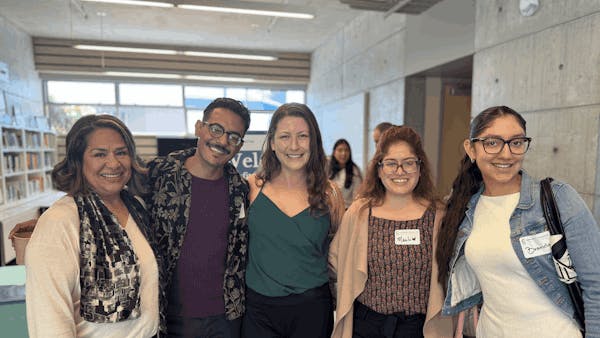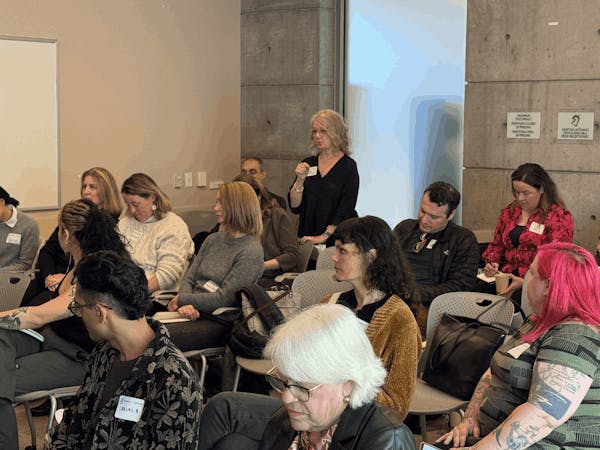Act Now
This giving season presents a unique opportunity to strengthen the place we call home. And this year, there's added reason to act.

Nonprofits learning together
Courage in Community
Nonprofits across Santa Cruz County are working hard to accomplish their missions and serve our neighbors as they adjust to shifting federal policies and budget uncertainties. Recently, over 50 nonprofit leaders and communications staff gathered at the Community Foundation for the learning session: “Nonprofit Communications in Uncertain Times.” They discussed how to strengthen messaging to donors, community members, and program participants about the impacts (and potential impacts) the administration is having on local organizations and encourage continued participation and giving.
The session, co-sponsored with Nonprofit Connection Santa Cruz County, was led by Tony Nuñez, the Community Bridges Communications and Marketing Manager and Pajaro Valley Healthcare District Board President and Sandy Skees, Executive Vice President of Global Purpose and Impact Practice at Porter Novelli and a member of Foundation’s Board of Trustees.

The conversation was guided by questions submitted beforehand by attendees. Here are the top takeaways:
Lead with courage, resolve and kindness
- Let your mission, vision, and values serve as the bedrock for all your communications.
- Invite your audience to take action, not just through monetary donations. People want to know how they can help, even if their own dollars are tight.
- People are hungry for kindness; center your storytelling on kindness and the services your organization provides.
- Know your points of confidence, stay true to who you are as an organization; do not censor your language about your values or the work you do.
To set the tone of your communications, it's important to understand the difference between an urgent situation and a crisis
- Urgency does not constitute a crisis. For example, if funding cuts are forcing your organization to downsize services, that’s an urgent need for fundraising. If a food bank has no food on its shelves or the viability of your organization is at risk, that’s a crisis.
- Be careful of when you “press the big red button” because you can only press it once.
- Work with executive leadership and your Board of Directors on a crisis communications plan so you have a framework in place if and when the need arises.
Protect your organization and staff
- If your organization is being targeted negatively, protect your staff by removing bios from websites and social media. This does not mean you aren't living your values; it means safety is always first.
- Do not engage with vitriol online. Turn off comments on social media posts if they become hateful/threatening. Prioritize safety over engagement.
- Check your organization's physical and digital security. Consult a professional to assess your building and other locations as well as your web and social platforms for security risks. Some firms will do a pro-bono consultation if your budget is tight.
- Train staff in de-escalation techniques to help diffuse potentially dangerous situations. The Conflict Resolution Center of Santa Cruz County is a helpful resource.
Center communications on transparency, impact, and authenticity
- Be transparent in your internal conversations about the challenges your organization is facing. This fosters trust among your staff.
- Train staff as trusted messengers: they are on the frontlines working with clients, program participants, and donors.
- Communicate urgency without desperation and center problem solving and solutions.
- Be truthful about the impact budget cuts and changing federal funding are having while remaining resolute in the face of these challenges.
Advocacy is effective, but it's a long-term investment
- Learn about your local government, how it works, and where potential funding might come from.
- Building advocacy relationships takes time; do not expect immediate results.

Attendees left the event with a feeling of renewed connection to each other and appreciation for the sense of community—knowing that they do not have to face these challenges alone.
“I really appreciate the Community Foundation providing opportunities for nonprofit organizations to be in community, connecting and figuring out more ways to strengthen our collaborations.”
- Event attendee
Stay tuned for upcoming workshops:
Wednesday, August 20
Building Our Nonprofit Brands: Visuals, Voice & Impact Measurement
With Melanie Zaragoza, Director of Development & Communications, The Diversity Center
Thursday, October 2
What’s Your Year-End Giving Communications GAME Plan?
With Jenny Kurzweil, Senior Communications Officer, Community Foundation Santa Cruz County
Header Photo: Resource Center for Nonviolence Executive Director Silvia Morales and staff member Carlos Avila alongside Community Action Board Development Director Hanna Rogers , Administrative Coordinator Marilu Bonilla, and Communications Administrative Specialist Brenda Hernandez.


